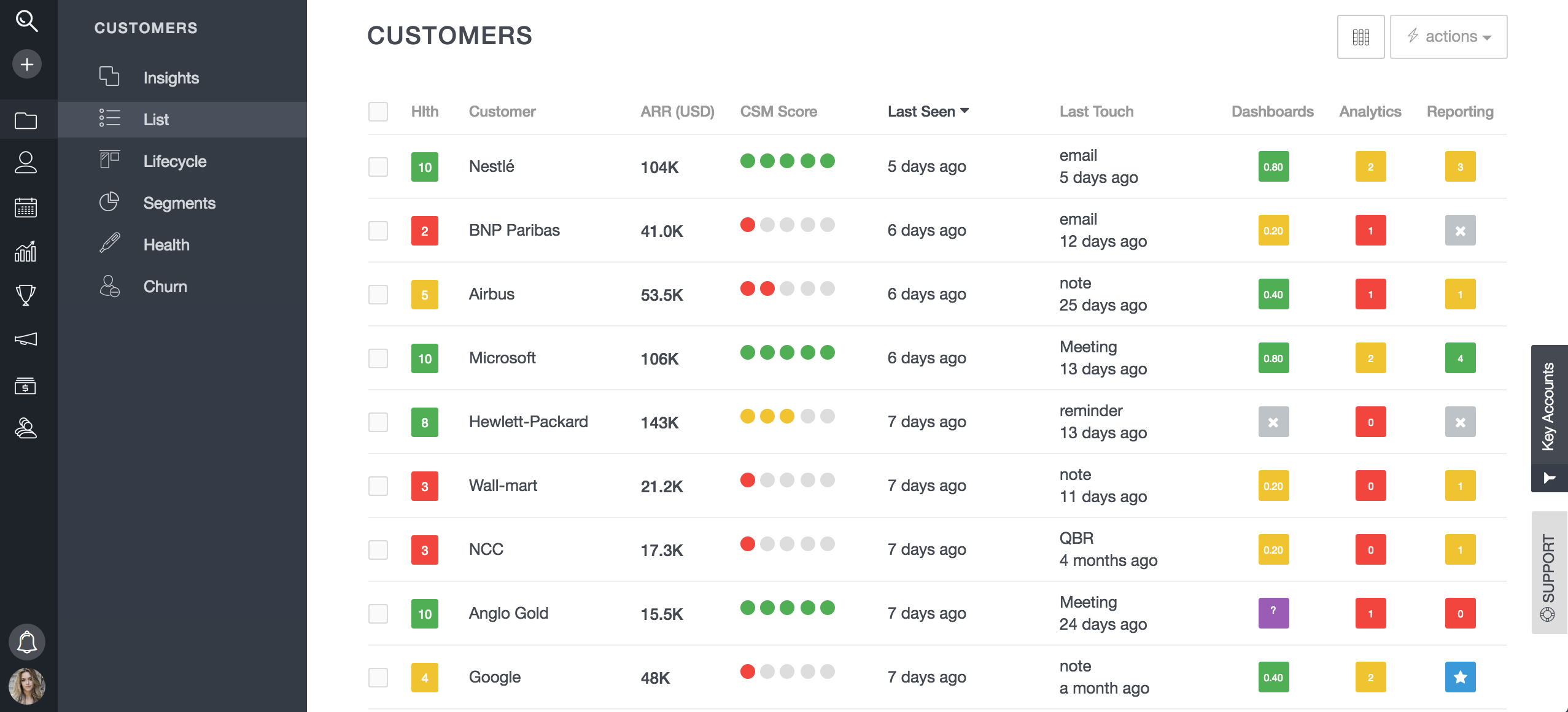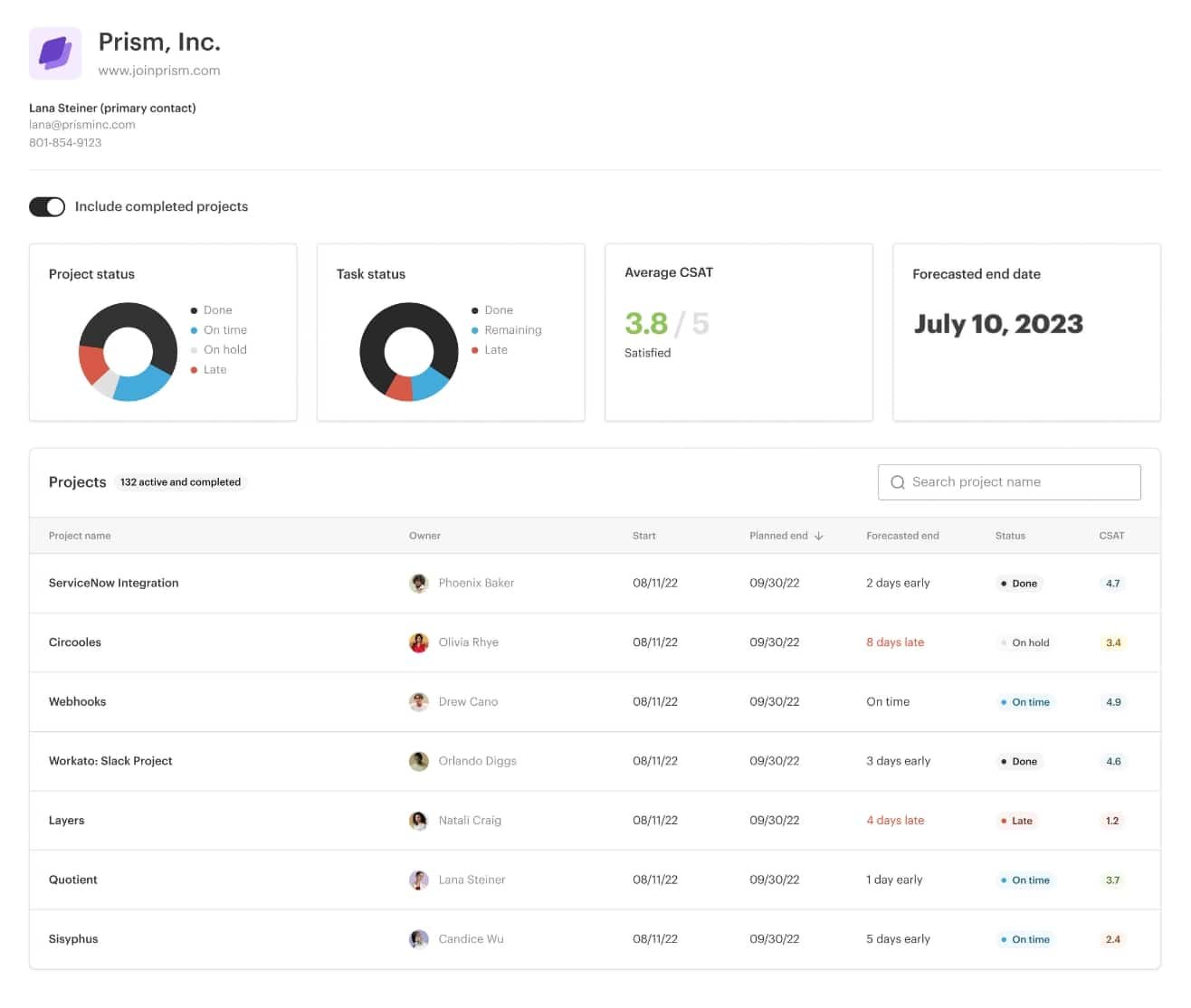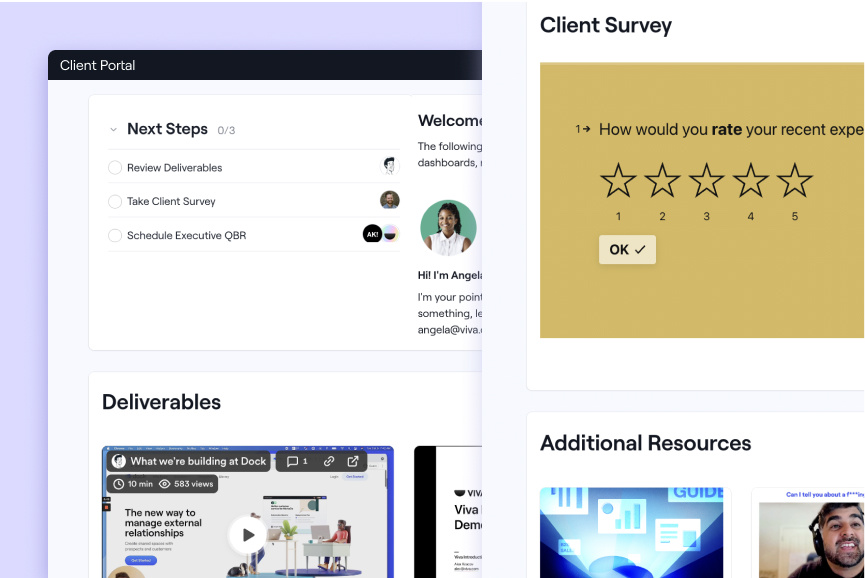The 12 Best Client Onboarding Software for 2025

Table of Contents
An efficient customer onboarding process is crucial for retaining clients and ensuring their success. However, implementing it is easier said than done. As a customer success leader, you need a customer onboarding tool that smooths collaboration, provides structure, and delights customers from day one.
The right customer onboarding solutions will save your team hours while accelerating time to value for new accounts. However, with so many customer onboarding tools on the market, identifying the top customer onboarding solutions can feel overwhelming.
That's where this customer onboarding solutions guide comes in. You're about to discover the 12 best client onboarding software tools to consider in 2025. We'll explore each customer onboarding solution's capabilities, so you can confidently select the best onboarding software to fuel your team's success.
What is Client Onboarding Software?
Client onboarding software, also known as customer onboarding software, streamlines the process of welcoming new clients. Client onboarding software ensures your clients are set up for success to fully adopt and implement your product or service. It typically includes features such as internal and external task management, client communication tools, tasks and playbooks, as well as automated workflows to facilitate an organized and efficient onboarding process.
What Should You Look for in Client Onboarding Software
First, let's cover the key features great customer onboarding solutions should deliver:
- Customized Onboarding Plans: The client onboarding software should enable you to create segmented onboarding playbooks tailored to each client.
- Centralized Task Management: It should enable you to manage all onboarding plans and activities from a unified hub for your team.
- Branded Customer Portals: A B2B customer portal should provide a white-labeled self-service portal for customers.
- Automated Workflows: Your customer onboarding tool should provide rules-based triggers to advance customers through different onboarding stages automatically.
- Reporting and Analytics: It should have advanced usage metrics that offer visibility into the onboarding program's effectiveness and adoption.
Overall, the best customer onboarding software centralizes the orchestration of your onboarding engagements while providing structure for customers. With those table stakes covered, let's explore the top customer onboarding tools on the market.
12 Best Client Onboarding Software to Use in 2025
After extensive research across the customer success tech landscape, these 12 customer onboarding solutions stand out as the premier client onboarding tools to consider in 2025:
1. OnRamp
OnRamp stands out as one of the best client onboarding platforms due to its user-centric design and innovative approach to customer engagement. It uniquely offers a dual-interface system: a customer portal designed specifically for end-users and an internal centralized project management platform for the onboarding team. This separation ensures a tailored experience for both clients and service providers, enhancing efficiency and satisfaction.
OnRamp's intuitive interface and automation capabilities streamline the onboarding process, making it a top choice for businesses looking to improve their client onboarding experience.
Pros:
- User-friendly customer portal
- Automation capabilities
- Flexible project management
- Comprehensive reporting
- Integration with major platforms
Cons:
- No free version
2. ChurnZero

ChurnZero excels in helping subscription-based businesses enhance their customer retention and prevent churn from the outset of the customer journey. It automates common onboarding activities, enabling CS teams to efficiently manage initial customer interactions, track progress, and intervene when necessary.
Pros:
- Automated onboarding activities
- Real-time alerts
- Customer health visibility
- Segmentation and automated campaigns
Cons:
- More expensive
- Feature overload without substance
- Unfriendly user interface (UI)
3. Planhat

Planhat differentiates itself by specializing in implementation management for deploying complex tech products. For professional services teams, Planhat provides structured tools to manage intricate customer journeys.
Pros:
- Customizable playbooks and portals
- Multi-channel communication
- Unlimited user model
Cons:
- Complex UI/UX
- Steep learning curve
 4. Rocketlane
4. Rocketlane
Rocketlane stands out as a collaborative customer onboarding platform. It's designed to bring consistency to project execution while offering transparency to both the service provider and the customer.
Pros:
- Built-in customer satisfaction tracking (CSAT)
- Unified workspace
- Comprehensive project views
Cons:
- Team based in India leading to time-zone and language barrier
- No social sign-in
5. GUIDEcx
GUIDEcx excels in streamlining the onboarding process, significantly reducing the time to value for customers. Its mobile app further ensures that project managers and stakeholders can stay connected and productive, even while on the go.
Pros:
- Streamlined onboarding process
- Mobile app
- Powerful integrations
Cons:
- Limited post-onboarding features
- Customization limitations
 6. Totango
6. Totango
Totango excels in providing visibility into customer health and facilitating scalable, efficient customer onboarding. It features an Onboarding SuccessBLOC with playbooks for success, automated workflows, and email communication templates.
Pros:
- Scalable solutions
- Visibility into customer health
- Prebuilt customer success program templates
Cons:
- Occasional bugs
- Limited reporting and task features
 7. Moxo
7. Moxo
Moxo offers customizable workflows, built-in interactivity with features like document collaboration and video conferencing, and branded service experiences.
Pros:
- Branded client portals
- Customizable workflows
- Offers KPI measurement and insights
Cons:
- Limited free version
- Feature limitations:
8. Dock.us
Dock.us offers a unified workspace where businesses can share onboarding checklists, track engagement on assets, collect feedback, and more. This platform simplifies the onboarding process by centralizing all necessary materials and tasks in one accessible location.
Pros:
- Drag-and-drop workspace editor
- Centralized onboarding materials
- Enhanced customer engagement
Cons:
- Complex setup
- High cost for advanced features
 9. Arrows.to
9. Arrows.to
Arrows.to integrates seamlessly with HubSpot, designed to enhance the onboarding process by driving engagement and ensuring customers complete their tasks efficiently.
Pros:
- Seamless HubSpot integration
- Automation and reporting
- Collaborative onboarding plans
Cons:
- Limited standalone functionality
- Customization limitations
10. Vitally
Vitally excels in boosting customer retention and satisfaction by providing a comprehensive view of customer interactions and data. It's designed to improve Net Revenue Retention (NRR).
Pros:
- 360-degree customer view
- Customizable health scores
- User-friendly interface
Cons:
- Occasional technical issues
- Initial setup complexity
11. Baton
Baton improves the onboarding process through automation and enhanced visibility for both clients and service providers. Its strength lies in its ability to facilitate seamless handovers between team members in projects, ensuring continuity and efficiency.
Pros:
- Improved workflow
- Enhanced collaboration
- Scalable implementation process
Cons:
- Steep learning curve
- Tracking issues
12. Onboard.io
Onboard.io aims to reduce customer churn and streamline the onboarding process. It excels in automating tedious tasks and managing onboarding from Slack. The software offers custom launch plans, integrates with existing systems, and provides a scalable solution for managing client onboarding and implementation processes.
Pros:
- Customizable customer journey
- Integration with tools like Slack, HubSpot, and Salesforce
- Scalable platform
Cons:
- Limited reporting capabilities
- Occasional reliability issues
Client Onboarding Software FAQ
What is Client Onboarding?
Client onboarding is the process of introducing a new client to your business. It involves ensuring they understand how to use your product or service. The goal is to establish a strong and lasting relationship with the client. This involves everything from initial kickoff to training and support. Client onboarding aims to help clients better adopt your product and achieve their goals.
Why is a well-structured new client onboarding process important?
New client onboarding and a well-structured onboarding process are critical for several reasons. Client onboarding tools enhance client satisfaction and retention. When clients experience a smooth and efficient onboarding process, they feel valued and understood. This fosters a positive impression of your company from the start.
Initial satisfaction often translates into long-term loyalty, reducing churn rates and increasing the likelihood of repeat business.
A well-organized client onboarding process reduces the time it takes for clients to see value from your product. By providing clear guidance and support, clients can quickly understand how to use your product effectively. This leads to faster realization of your benefits. Reducing time to value not only boosts client satisfaction but also strengthens client trust in your offering.
Setting clear expectations and reducing friction are also crucial aspects of effective client onboarding. A structured client onboarding process helps clients understand what will happen and avoids confusion. Aligning client expectations provides clarity and prevents potential issues enhancing the overall client experience.
Lastly, a solid onboarding process builds a strong foundation for a long-term relationship. To build a strong partnership, it is important to maintain open communication and demonstrate your commitment to their success. This will establish a solid foundation for a lasting relationship. This proactive approach helps nurture trust and ensure that clients feel support throughout their client success journey.
Steps in the Client Onboarding Process
Effective client onboarding involves several key steps:
- Initial Contact: Establish communication and set expectations.
- Needs Assessment: Understand the client’s requirements and goals.
- Planning: Develop a custom onboarding plan specific for your client's use case.
- Execution: Implement the plan, provide training and support.
- Follow-up: Monitor progress and provide ongoing assistance.
Benefits/Advantages of Using a Client Onboarding Tool
Using a client onboarding tool provides numerous benefits. It enhances efficiency by automating repetitive tasks, thereby saving valuable time. Client onboarding tools ensure consistency by delivering a uniform onboarding experience across all clients.
Client onboarding software offers tracking capabilities, providing visibility into the onboarding process and monitoring progress at every stage. Additionally, it supports customization, enabling tailored onboarding playbooks that address specific client requirements effectively.
Best Practices for New Client Onboarding
To ensure a successful onboarding process, it’s essential to follow several best practices. Start with clear communication by maintaining open lines with the client throughout the process. Personalize the onboarding experience to address the client’s specific needs, and leverage automation to streamline repetitive tasks and save time. Collecting feedback is crucial for continuously improving and refining the onboarding process. Lastly, provide ongoing support to address any issues promptly, ensuring a smooth transition and positive client experience.
How to Determine Which Client Onboarding Software is Best for Your Team
When selecting client onboarding software, consider the following questions:
- What are the client onboarding tools features?
- Ensure the client onboarding software meets your specific needs. Decide what features are must-have vs. nice to have.
- How easy is this client onboarding tool to use?
- Choose a client onboarding software that is user-friendly. This should be especially true for non-technical end customers.
- Will this client onboarding tool scale as our team and customer base grows
- Make sure the client onboarding software you choose can grow with your business.
- What tools in our tool stack can this client onboarding tool integrate with?
- Check if the client onboarding software integrates with your existing tools.
- What is the price of client onboarding software?
- Consider your budget and the software’s pricing structure. Do you have what you need to pitch the ROI of client onboarding software to decision makers?
Client Onboarding Software Needs by Company Size
The needs for client onboarding software can vary by company size:
- Small Businesses: Look for affordable, easy-to-use solutions with essential features.
- Medium-Sized Businesses: Opt for software with more advanced features and customization options.
- Large Enterprises: Choose scalable solutions with robust features and integration capabilities.
Difference Between Client Onboarding Software and Customer Success Platforms
While client onboarding software focuses on the initial stages of integrating new clients, customer success platforms cover the entire client lifecycle, including retention and growth strategies. Both are essential but serve different purposes within the customer journey.
Difference Between Client Onboarding and Project Management Tools
Client onboarding software is specialized for guiding new clients through the onboarding process, whereas project management software is more general-purpose, managing a variety of projects and tasks beyond just onboarding.
The ROI of Investing in Client Onboarding Software
Investing in client onboarding software can yield significant returns for your business. Investing in a client onboarding tool is a strategic decision that goes beyond mere operational efficiency. Here’s how you can present the ROI of client onboarding software to decision-makers:
Increased Customer Retention
Effective onboarding sets the tone for a long-term relationship. Satisfied clients who have a smooth onboarding experience are more likely to stay with your company, reducing churn rates. This stability translates to predictable revenue streams and enhances customer lifetime value (CLV).
Reducing Time to Value
Onboarding software streamlines the process, allowing clients to realize the benefits of your product or service more quickly. Reduced time to value not only boosts customer satisfaction but also shortens the sales cycle, enabling faster revenue generation.
Enhanced Productivity
Automating repetitive tasks and centralizing information reduces the workload on your customer success and onboarding teams. This efficiency allows your team to focus on more strategic activities, such as personalized client interactions and upsell opportunities, ultimately driving higher productivity and revenue.
Improved Client Satisfaction
A structured and seamless onboarding experience leads to happier clients. Positive client experiences increase the likelihood of referrals and positive reviews, which can significantly impact new client acquisition without additional marketing spend.
Cost Savings
By reducing manual processes and errors, onboarding software minimizes the resources needed to bring new clients up to speed. This reduction in operational costs, combined with increased efficiency, results in substantial cost savings over time.
Data-Driven Insights
Onboarding software provides valuable analytics and reporting, offering insights into client behaviors and onboarding effectiveness. These data-driven insights enable you to continuously improve your client onboarding process. They also allow you to tailor client services specifically to client needs, and make informed business decisions.
Competitive Advantage
Companies that invest in client onboarding software stand out against their competitors. A superior onboarding experience can be a compelling selling point, giving you an edge over competitors and helping to attract high-value clients.
ROI Metrics
To quantify the ROI of client onboarding software, consider metrics such as:
- Reduction in churn rate: Lower churn leads to higher revenue retention.
- Decrease in onboarding time: Faster onboarding equates to quicker revenue realization.
- Increase in client satisfaction scores: Higher satisfaction often correlates with increased upsell and cross-sell opportunities.
- Operational cost savings: Reduced manual efforts and errors translate to direct savings.
By presenting these points to decision-makers, you can effectively illustrate the tangible and intangible benefits of investing in client onboarding software, making a compelling case for its adoption as a strategic tool for growth.
Investing in client onboarding software is not just an operational decision. It's a strategic move that drives long-term value and competitive advantage.
Enhance Your Client Onboarding Process with OnRamp
Onboarding that delights customers and gets them active fast makes the difference between one-time sales and multi-year success stories. As a customer leader, you need the top client onboarding software that eliminates friction across onboarding while ensuring retention and growth.
OnRamp stands out as one of the best client onboarding portals, providing specialized UIs for both internal teams and external clients. With separate platforms optimized for users on both sides, it facilitates project management while offering self-service capabilities. It empowers you to provide white-glove experiences that convert new customers into brand advocates.
Schedule a demo today to learn more about elevating customer onboarding with OnRamp's flexible software.
Related Posts:

Everything You Need to Know About B2B SaaS Onboarding Software
The global SaaS market is booming, with experts predicting it will reach a staggering $1.016 trillion by 2032. However, one critical...

How To Scale Efficiently With Customer Onboarding Automation
Technology powered by artificial intelligence (AI) is all the buzz in every industry this year. In 2025, we expect automation to go...

Customer Onboarding Process Strategies to Drive ROI and Retention
Customer onboarding is more than a handshake or a welcome email – it’s the first critical impression that defines your relationship...

